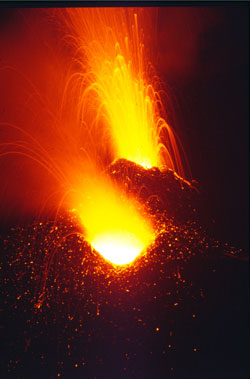Channeling, via Fire and Ice

When Sicily’s Mount Etna erupted in 2001, rivers of super-hot lava scoured the mountainside, leaving channels up to 6 meters deep in their wake. A volcanologist who observed one of those channels has now published results that contradict conventional wisdom about how volcanoes sculpt the earth. According to his paper in the 20 January PRL, lava can sometimes scrape away rock the way glaciers do, rather than melting its way through. The find could give insight into the geology of similar channels on the moon, Venus, and other denizens of our solar system.
Geoscientists have long known that glaciers cut through rock as they inch from the interior of a continent out to sea, a process called mechanical erosion. Lava, in contrast, is thought to melt rock and wash it away, through so-called thermal erosion. The effects of any mechanical scraping–say, by stray boulders carried in a lava flow–should be small in comparison to melting, according to the standard theory. But researchers haven’t documented a large number of field examples supporting this view, say volcanologist Carmelo Ferlito and physicist Jens Siewert of the University of Catania in Italy.
Ferlito became aware of the issue after his experience during Etna’s 2001 eruption. For a week he watched lava ooze out slowly and solidify in layers on the ground, as Etna bellowed ash. Then a 16-meter-tall lava flow sent a new stream down the mountain, one that carved straight through the newly-hardened rock. 12 hours later Ferlito spied the new channel, its sides cleanly cut away, with 11 layers of hardened lava clearly visible. If the new lava had melted through, “the banks should be more uniform and no strata would be visible,” he says. “The layers would have been ‘welded’ together.” Plus, thermal erosion usually requires rock to be heated for days or weeks, not hours.
In their paper, Ferlito and Siewert calculate the heat energy that would have been required to melt the volume of rock the lava removed from the 220-meter-long channel. Given just 12 hours of melting time, they conclude, the lava would have needed to conduct heat about twice as well as silver and a thousand times as well as other lavas, leading the team to rule out thermal erosion as the dominant process.
Next the researchers apply a simple equation from the study of wear in materials that relates the amount of wear to the force, hardness, and path length of the abrasive, and show that it’s consistent with their observations of the lava channel. Finally, they predict theoretically the rate at which mechanical erosion can cut channels and note that it can be much faster than the thermal process. The team suggests that the mechanical process might explain some puzzling examples of erosion in the scientific literature where conditions seemed not to favor thermal erosion, although they don’t dispute that thermal erosion is often important.
David A. Williams, a geologist at Arizona State University in Tempe, has found sites at Mount St. Helens in Washington state where lava may have mechanically eroded avalanche rock–the only previous evidence for the mechanical process. He says the Etna description “provides many new insights.”
But geophysicist Ross Kerr of the Australian National University in Canberra wonders whether the underlying volcanic rock had actually solidified before the channel formed. To respond to such concerns, Ferlito and Siewert plan to study similar channels elsewhere. Should their hypothesis work out, geophysicists may need to consider two kinds of erosion by lava when they ponder surface features on Earth and other planets and moons.
–Pam Frost Gorder
Pam Frost Gorder is a freelance science writer in Columbus, OH.


